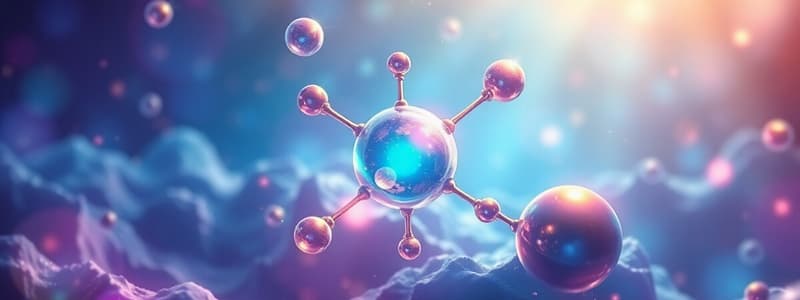Podcast
Questions and Answers
Which of the following describes the process of calculating moles from grams?
Which of the following describes the process of calculating moles from grams?
- Dividing grams by atomic mass (correct)
- Subtracting grams from molar mass
- Multiplying grams by molecular weight
- Adding grams to the atomic weight
In the context of balancing chemical equations, which term is used to describe substances that undergo a change during the reaction?
In the context of balancing chemical equations, which term is used to describe substances that undergo a change during the reaction?
- Products
- Reactants (correct)
- Intermediates
- Catalysts
What is the primary purpose of using the ideal gas law (PV=nRT) in calculations?
What is the primary purpose of using the ideal gas law (PV=nRT) in calculations?
- To find the solubility of a gas in a solvent
- To calculate the density of a liquid
- To determine the mass of a gas
- To relate pressure, volume, temperature, and moles of a gas (correct)
How is the oxidation number of an element in a compound determined?
How is the oxidation number of an element in a compound determined?
What does the empirical formula represent?
What does the empirical formula represent?
Which of the following factors does NOT affect the rate of effusion of a gas?
Which of the following factors does NOT affect the rate of effusion of a gas?
Which of the following best explains the concept of bond energy?
Which of the following best explains the concept of bond energy?
When conducting a titration, which of the following equations is crucial for relating the concentrations and volumes of two solutions?
When conducting a titration, which of the following equations is crucial for relating the concentrations and volumes of two solutions?
Which atomic property generally increases as you move down a group in the periodic table?
Which atomic property generally increases as you move down a group in the periodic table?
What does the term 'solubility product constant' (Ksp) refer to?
What does the term 'solubility product constant' (Ksp) refer to?
Flashcards
Gram Formula Mass (Molar Mass)
Gram Formula Mass (Molar Mass)
The mass of one mole of a substance, expressed in grams per mole (g/mol). It represents the sum of the atomic masses of all atoms in a molecule.
Parts per Million (ppm)
Parts per Million (ppm)
A way to express the concentration of a substance in a solution or mixture. It indicates the number of parts of the substance per one million parts of the solution.
Grams to Moles Conversion
Grams to Moles Conversion
Converting between mass (grams) and the amount of substance (moles) using the molar mass of the substance.
Moles to Molecules Conversion
Moles to Molecules Conversion
Signup and view all the flashcards
Percent Composition
Percent Composition
Signup and view all the flashcards
Naming Compounds
Naming Compounds
Signup and view all the flashcards
Calculating Protons, Neutrons, and Electrons
Calculating Protons, Neutrons, and Electrons
Signup and view all the flashcards
Average Atomic Mass
Average Atomic Mass
Signup and view all the flashcards
Counting Atoms in a Compound
Counting Atoms in a Compound
Signup and view all the flashcards
Empirical Formula
Empirical Formula
Signup and view all the flashcards
Study Notes
General Chemistry 1 Final Review
- Topics: 36 topics, 12 per day over 3 days
- Gram formula mass/molar mass
- Parts per million
- Grams to moles
- Moles to molecules
- Percentage composition
- 2 significant figure questions
- Periodic table questions (metals, metalloids, nonmetals)
- Atomic radius
- Compound naming
- Calculating protons, neutrons, electrons
- Average atomic mass
- Counting atoms in a compound
- Empirical formula
- Atomic orbitals (ms, ml, n, know definitions)
- Balancing chemical equations
- Net ionic equations
- Solubility questions
- Bond energy/enthalpy
- Enthalpy calculations (q=mcΔT)
- Coffee cup calorimetry (qmetal = qwater)
- Oxidizing agent
- Reducing agent
- Oxidation numbers
- Lewis dot structures
- Bond angle questions
- Molecular geometry
- Resonance structures
- Formal charges
- Ideal gas law (PV=nRT, R=0.0821)
- Effusion
- Gas density calculations
- Limiting reactant questions
- Intensive vs. extensive properties
- Solubility questions
- Titration (MaVa = MbVb)
Studying That Suits You
Use AI to generate personalized quizzes and flashcards to suit your learning preferences.



